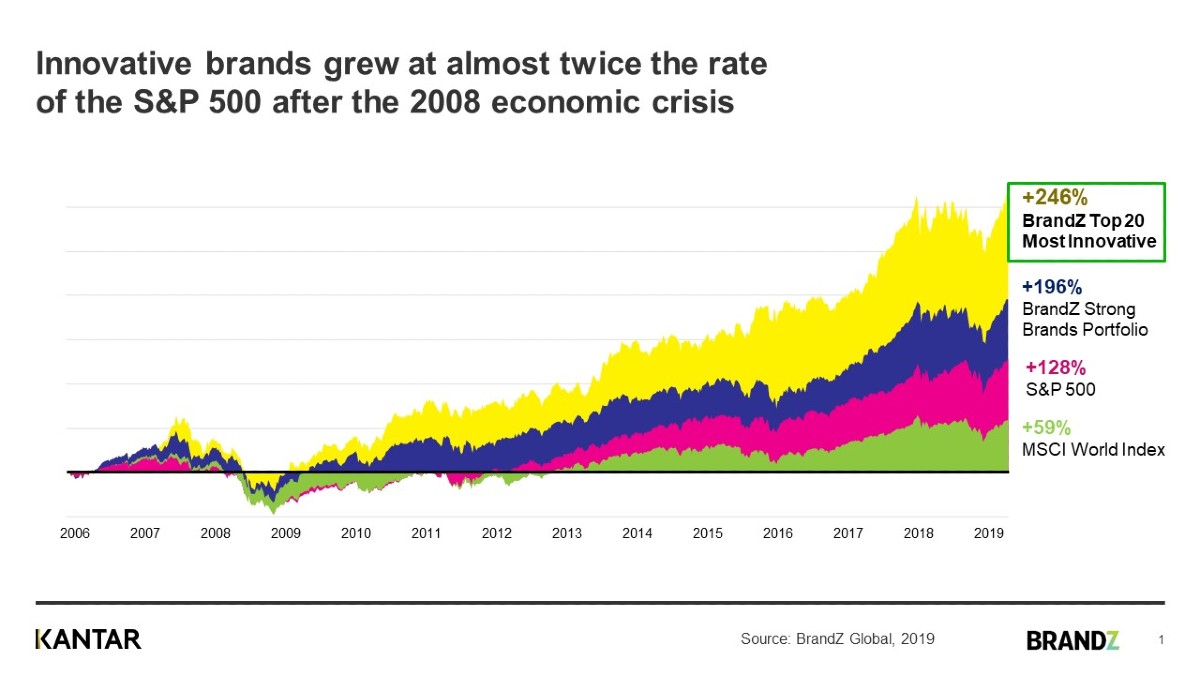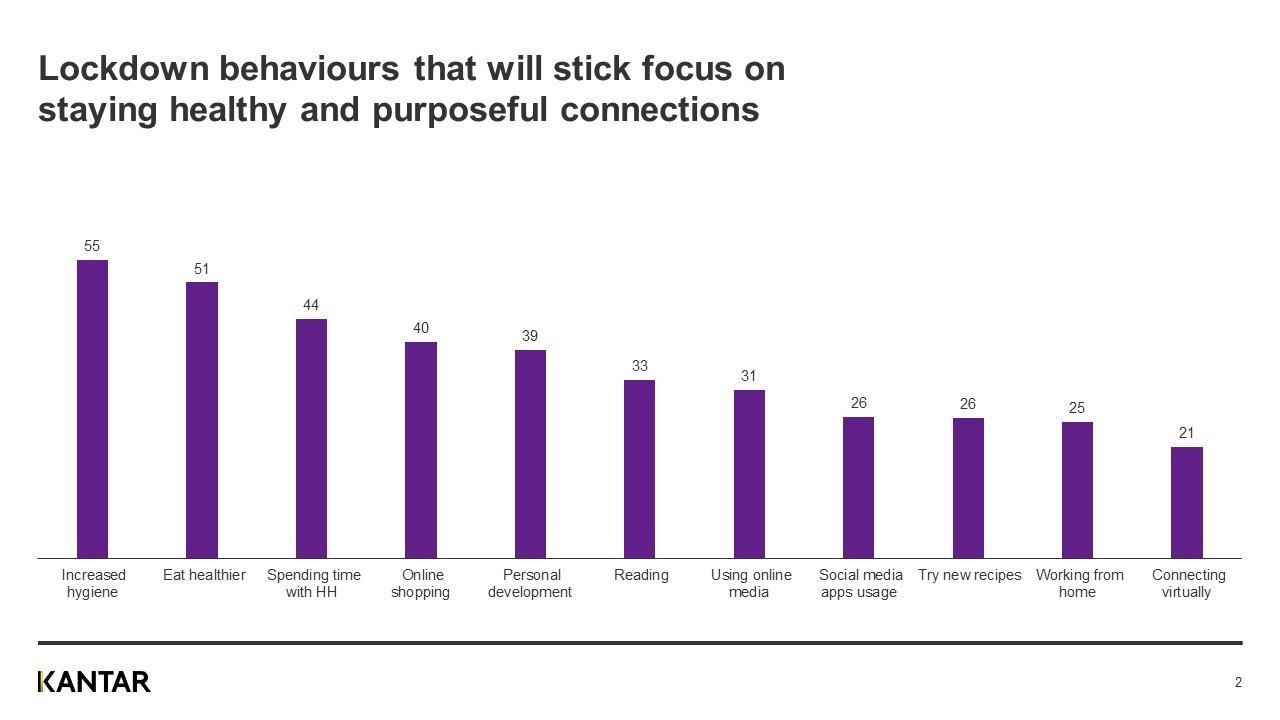For many businesses, the only objective at the moment is to remain afloat. But even businesses that have enough cash reserves to weather the storm can place themselves in a worse position. In times of crisis, businesses often fall prey to strategic decision-making that sacrifices long-term success at the altar of short-term gains. Such times require strong leadership, wisdom and insight.
Kantar’s Europanel research from the 2008-2011 recession found that winning brands launched 60% more innovations than brands that lost share ‘at the shelf’ over this period*. And Kantar BrandZ data shows that the stock price of the top 20 most innovative brands grew 246% after the 2008 economic crisis – almost twice the rate of the S&P 500. As we look to the post-pandemic recovery, the need for innovation has never been more relevant, and resilient organisations don’t stop innovating. Brands that maintain forward momentum and continue to innovate with a view of the longer-term fare better than those that don’t.

A new rhythm of life
Kantar’s most recent COVID-19 Barometer shows that people’s attitudes and behaviours are changing to adjust to the new rhythms of life and they are making different choices. Other than practicing good hygiene, people are eating better, spending quality time with family and focusing more on personal development. The Barometer also shows that in countries where lockdown persists 31% of people say they are starting to like their new behaviours. Conversely, in countries where lockdown is lifting just 10% declare they will maintain these new behaviours.
It is difficult to predict exactly how the future will shake out, but more than half of people worldwide (52%) believe they will maintain lockdown behaviours post-pandemic. So, businesses must commit to understanding how consumer needs, behaviours and attitudes are evolving.

A time to innovate
Existing products and services and new innovations need to anticipate and meet these evolving needs and changing lifestyles. They need to resolve people’s tensions and fulfil their aspirations.
Understanding where and how new opportunities, needs and behaviours are emerging is an chance for brands to pivot and realign their innovation pipeline. The proven strategy for weathering downturns is to invest more not less, and the disruption in the marketplace now is an opportunity not to be missed.
Modern business innovation paradigms dictate that brands must innovate often and fast. Quantity and speed can be important. But innovating in this manner can lead to high precision and low accuracy, meaning businesses do a good job of solving the wrong problem, miss the mark with product launches and fail to deliver incremental growth. Successful innovation can be elusive without organisational agility. Organisations that nurture a culture of agility are nimble. They put people’s needs at the heart of innovation and take calculated risks, to produce more and successful innovations.
Agility is key to post-pandemic success
Agility is often part of the DNA of start-ups. They are curious, ambitious and are less invested in the status quo, so they can quickly pivot to capitalise on pockets of opportunity and areas for growth. Organisational agility around innovation is not something that can be created overnight, but it is critical in times of crisis. And incumbents can be just as agile as disruptors if they consciously cultivate the culture that it requires.
This begins with an understanding that operational and brand silos can impede innovation, making a business less efficient at harnessing insights and are more apt to waste great ideas. Instead, businesses that orient around the customer through smaller, fluid working groups, that aim to better understand and serve the customer, deliver more effective innovation results.
Put people front and centre
Next, this process requires that business objectives are reframed as consumer tensions. ‘Expand product range to compete with growing need for protection’ becomes ‘help people plan for financial security’. ‘Diversify portfolio to better compete with disruptor trends’, becomes ‘develop an offering that supports peoples’ need for safety and wellbeing through 100% organic ingredients. Businesses that organise around insight-led innovation territories are better able to utilise the processes of expansion and contraction that make design thinking so effective.
Test and learn
Embracing and minimising appropriate risk is a necessary criterion to supporting a test-and-learn environment. Striking the right balance between risk and rigour can be difficult and requires endorsement from the top of the organisation and reward in practice. This is often the hardest aspect for well-managed, performance-based and KPI-driven businesses.
Toyota CEO Akio Toyoda highlighted the importance of this value within the organisation, when he commented at Toyota’s earnings press conference in May that, "...being able to quickly quit things during this opportunity, and being able to quickly change the way things are done, and, being able to use this opportunity to further press the accelerator to actually achieve a new Toyota is something that is happening more rapidly, I believe."
Incremental testing, learning, adjusting and the concept of a getting a minimum viable product (MVP) to market rest at the heart of agile innovation. But overly risk averse, stage-gated evaluation and development processes can also have deleterious effects, slowing progress and creating too many innovation pipeline ‘false negatives’, whereby potentially successful ideas, concepts or products don’t make it through. Innovation inherently delves into unchartered territory.
Finally, innovation agility means more frequent review with real consumer feedback. Kantar’s eValuate suite of innovation and product development solutions, now available on Kantar Marketplace, can help businesses accelerate innovation cycles and speed to market. With quick turnaround in as little as 24 hours for concept testing, businesses can quickly sense check ideas with consumers. This is indispensable when exploring new territories. For example, we understand from Worldpanel data that people in lockdown are cooking more often but aren’t spending longer doing so. Preparation times have not increased, yet people are focused on using up cupboard stock. Food brands looking to innovate in this territory will want to test well-developed concepts with consumers to ensure they hit just the right needs spot, and a balance between empowering ‘real’ cooking and keeping things quick.
Driving recovery
New attitudes and behaviours will inevitably stake a claim in post-pandemic lives. As businesses look to recover from COVID-19 and thrive longer-term, they must refocus crisis resources around being curious about customers’ lives again. People’s evolving preferences will impact the direction of innovation, and businesses need to explore what will have relevance and appeal. Businesses must lean on agile innovation principles if they expect to deliver meaningfully different products to market at speed that have the right value proposition. Efficient and effective innovation now will speed brand recovery from the economic strain of the pandemic and will strengthen a brand for future growth.
*Source: BG20: Global database of 20,000 brands built to understand the drivers of brand growth
